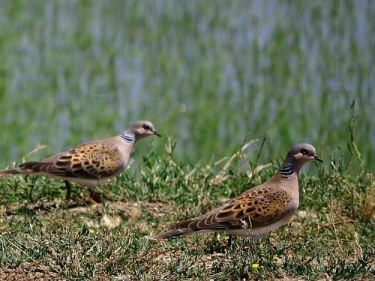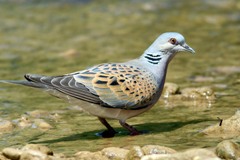How does it reproduce?
 Doves,
including the turtle dove, are world-wide symbols of love.
This is because the turtle dove is monogamous and pairs for
life. Also, males are as actively involved in taking care
of his young from egg to the time the young leave the nest as
the mothers are.
Doves,
including the turtle dove, are world-wide symbols of love.
This is because the turtle dove is monogamous and pairs for
life. Also, males are as actively involved in taking care
of his young from egg to the time the young leave the nest as
the mothers are.
Before eggs even come into the picture, courtship has to occur. Mating season for turtle doves is from May-July, while they are in their Northern habitat. During this time, male turtle doves put on a display to the females by puffing out their chest and bobbing up and down with a lowered beak. If a female turtle dove likes the male's display and chooses him, they will then build a nest. The nest is very frail and made out of thin twigs. Sometimes it is lined with plant stems, roots or even hair.
The female will lay one or two white, oval eggs. Both parents help incubate the egg; typically the male will incubate it during the day, while the female take the night shift. Incubation of the eggs lasts about fourteen days. Again, both parents feed and care for the young. After another fourteen days, the young are fledged. The parents will have two or three clutches of eggs per mating season.
Apart from the direct care of the eggs and young birds, the parents must also defend their nest from potential predators. In a typical season about a third of the eggs and almost half the young are eaten by nest robbers, including magpies and jays.
